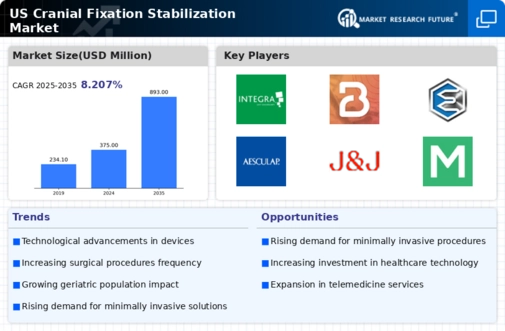Surge in Geriatric Population
The demographic shift towards an aging population in the US is another critical factor influencing the cranial fixation-stabilization market. By 2030, it is projected that 20% of the US population will be aged 65 and older, according to the US Census Bureau. This demographic is more susceptible to conditions requiring cranial stabilization, such as falls leading to head injuries and degenerative diseases. The increased incidence of these conditions among older adults necessitates the development and adoption of specialized cranial fixation devices. Additionally, healthcare providers are likely to invest in innovative solutions to cater to this growing segment, thereby propelling market growth. The cranial fixation-stabilization market must adapt to the unique needs of the geriatric population, ensuring that products are both effective and user-friendly.
Advancements in Surgical Techniques
Innovations in surgical techniques are transforming the landscape of the cranial fixation-stabilization market. Minimally invasive procedures are gaining traction, allowing for reduced recovery times and improved patient outcomes. Techniques such as endoscopic surgery and robotic-assisted procedures are becoming more prevalent, necessitating the development of specialized cranial fixation devices that align with these advancements. The market is witnessing a shift towards products that offer enhanced precision and stability during surgeries. As surgeons increasingly adopt these advanced techniques, the demand for compatible cranial fixation solutions is expected to rise. Furthermore, the integration of technology in surgical procedures may lead to the emergence of new products, thereby expanding the cranial fixation-stabilization market. This trend indicates a dynamic interplay between surgical innovation and market growth.
Increasing Incidence of Neurological Disorders
The rising prevalence of neurological disorders in the US is a significant driver for the cranial fixation-stabilization market. Conditions such as traumatic brain injuries, tumors, and congenital anomalies necessitate advanced surgical interventions. According to the National Institute of Neurological Disorders and Stroke, approximately 795,000 people experience a stroke annually, highlighting the urgent need for effective cranial stabilization solutions. This growing patient population is likely to increase the demand for cranial fixation devices, as healthcare providers seek to improve surgical outcomes and patient safety. Furthermore, advancements in surgical techniques and materials are expected to enhance the effectiveness of these devices, thereby driving market growth. As the healthcare system continues to evolve, the cranial fixation-stabilization market is poised to expand in response to these increasing clinical needs.
Rising Investment in Healthcare Infrastructure
The ongoing investment in healthcare infrastructure across the US is a pivotal driver for the cranial fixation-stabilization market. Government initiatives and private sector funding are directed towards enhancing surgical facilities and equipping them with advanced technologies. According to the American Hospital Association, total hospital expenditures reached approximately $1 trillion in recent years, reflecting a commitment to improving healthcare delivery. This investment is likely to facilitate the adoption of cutting-edge cranial fixation devices, as hospitals seek to provide high-quality care. Additionally, the establishment of specialized neurosurgical centers is expected to further drive demand for cranial stabilization solutions. As healthcare infrastructure continues to evolve, the cranial fixation-stabilization market stands to benefit from these developments.
Growing Awareness and Education on Brain Health
The increasing awareness and education surrounding brain health are influencing the cranial fixation-stabilization market. Public health campaigns and educational initiatives are shedding light on the importance of brain injury prevention and treatment. Organizations such as the Brain Injury Association of America are actively promoting awareness, which may lead to higher demand for cranial fixation solutions. As individuals become more informed about the risks associated with head injuries, there is a potential increase in the utilization of cranial stabilization devices during surgical procedures. Furthermore, healthcare providers are likely to respond to this heightened awareness by offering more comprehensive treatment options, thereby expanding the cranial fixation-stabilization market. This trend underscores the importance of education in driving market growth.






















Leave a Comment